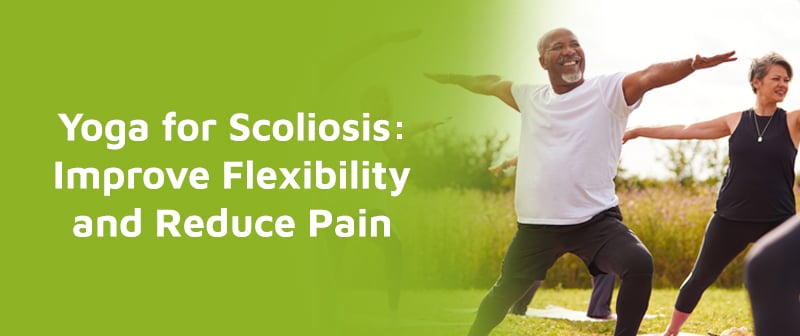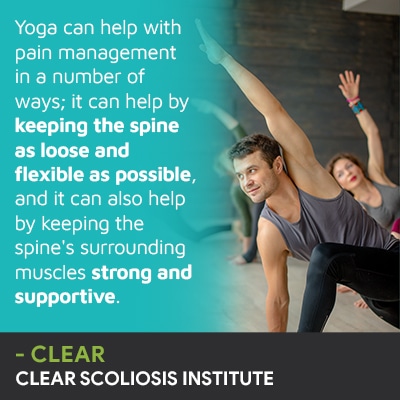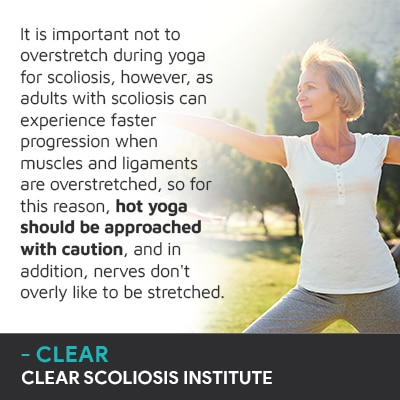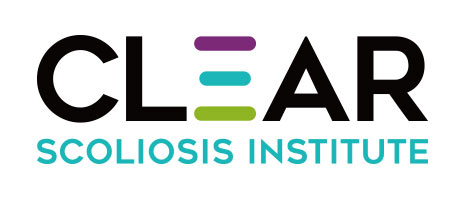
Scoliosis is a complex condition; its treatment plans need to be fully customized to address specific condition and patient factors that vary from person to person. When scoliosis-specific and combined with a proactive treatment plan, yoga for scoliosis can help in a number of ways; continue reading to find out more.
Yoga is an ancient practice capable of increasing spinal/core strength and flexibility, while also offering pain relief and mental health benefits associated with breathing awareness and relaxation. Scoliosis yoga can help relieve pain, increase spinal stability, and improve the spine's range of motion.
As a scoliotic spine is exposed to a lot of uneven forces, it needs to be comprehensively assessed and understood before any type of treatment is started, including yoga for scoliosis.
Patients diagnosed with scoliosis have developed an unhealthy spinal curve that bends to the side unnaturally, and as a 3-dimensional condition, a scoliotic spine also twists (rotates).
And as a progressive condition, most cases of scoliosis will get worse over time, and this means the spinal curvature becomes larger, and this is triggered by growth and/or spinal degeneration, depending on patient age.
The main cause of progression is growth, so children who haven't yet reached skeletal maturity are more at risk for rapid progression; adults who have stopped growing are more at risk for compression and pain involving increasing spinal degeneration and instability.
In children, scoliosis doesn't commonly involve a lot of pain as it's compression that causes most scoliosis-related pain in the form of back pain and pain that radiates into the arms and legs due to nerve compression.
In young patients whose spines are still growing, the spine is constantly being lengthened which counteracts the compressive force of the scoliotic curve, so pain management is more a focus of treatment in adult scoliosis than in childhood scoliosis.
In adults, particularly older adults, spinal degeneration is a factor, and the more natural age-related spinal degeneration an adult is facing, the more likely they are to develop degenerative scoliosis and/or increase the rate of their scoliosis progression.
It's important that the specific details of a patient's scoliosis are factored into the design and customization of any type of treatment, including yoga for pain relief, and this includes the curvature type, severity, location and pattern, along with the angle of spinal rotation and particular areas of weakness.
The uneven forces of scoliosis can cause pain and the spine to become increasingly unstable and unbalanced; when combined with proactive conservative treatment, yoga for scoliosis can help in a number of ways.

So as adults are more likely to experience scoliosis pain than children, yoga for scoliosis pain management is more relevant when discussing adult scoliosis that's compressive.
Compression is uneven force, and as the spine and brain from the central nervous system, with the spine containing 31 pairs of spinal nerves, nerve compression can also cause pain that radiates into the extremities, and this is a common symptom of adult scoliosis.
A common location for adult scoliosis is the lumbar spine, and this is because it has to support the weight of the trunk, the thoracic and cervical spinal sections above, and the vertebrae of the lower back feel the strain of movement and lifting.
An adult's spine is more rigid and less flexible than a child's, and the more stiff a spine is, the more likely back pain is, along with stiff, sore, and potentially unbalanced spinal muscles.
Lumbar scoliosis often involves torsion/twisting of its discs; an intervertebral disc sits between adjacent vertebral bodies, and the more rotation there is, the more painful scoliosis tends to be, and the more likely nerve-related pain is.
Yoga can help stretch and strengthen the spine, along with its surrounding muscles, and certain yoga poses can also take pressure off a compressed nerve, providing nerve-pain relief.
In many cases of lumbar scoliosis, leg pain is common, and this can also involve sciatic nerve pain as the sciatic nerve starts in the lumbar spine and extends down the back of the body's left side (in most cases).
A notable benefit of yoga is its potential to increase core strength; this increases the spine's stability and support, and this can help to address areas of torsion to derotate the spine and address the underlying structural cause of the back pain.
De-rotating the spine also means reducing its uneven forces and taking pressure off the spine's discs, surrounding muscles, and nearby nerves to relieve symptoms of nerve compression.
A yoga-specific instructor can customize a program that targets a patient's specific areas of rotation and torsion, but these poses have to be designed and supervised by a yoga for scoliosis instructor, or they can be too general and cause further damage and pain.
Certain yoga poses can help lumbar scoliosis by derotating and lengthening the lumbar spine and increasing core strength, helping with spinal stability and pain management.
As the size of a scoliotic curve increases with progression, the spine becomes increasingly rigid and less flexible, reducing the spine's natural range of motion: something that can greatly impact a patient's overall quality of life.
Yoga for scoliosis can help address spinal rigidity by increasing spinal flexibility for a wider range of motion.
Careful stretching of the spine can create space with the spine and take pressure off its discs, surrounding nerves and muscles, and as yoga can also increase core strength, it can also help address any scoliosis-related muscular imbalance.
It is important not to overstretch during yoga for scoliosis, however, as adults with scoliosis can experience faster progression when muscles and ligaments are overstretched, so for this reason, hot yoga should be approached with caution, and in addition, nerves don't overly like to be stretched.
The dangers of overstretching for people with scoliosis are another reason a trained scoliosis-specific yoga specialist is so important, and when it comes to the power of yoga as a facet of treatment capable of impacting the scoliotic curve itself, this is only possible when scoliosis-specific and combined with other forms of conservative treatment with corrective potential.

The complex nature of scoliosis necessitates a multi-faceted treatment approach; no one form of treatment is enough to correct scoliosis on its own, but when integrated into a proactive conservative treatment plan, different types of treatment can complement each other to impact scoliosis on multiple levels.
Through the combination of scoliosis-specific chiropractic care, physical therapy, scoliosis-specific exercises, corrective bracing, and a variety of therapies (yoga included), patients can benefit from working towards a curvature reduction on a structural level, increasing core strength and stability through physical therapy and exercise, bracing, and rehabilitation.
The more customized a treatment plan is, the more specific its potential results can be; patients can benefit from the pain-management and core muscles strengthening benefits of a customized yoga routine, while practicing breathing techniques and breathing awareness during certain poses can also help encourage postural awareness and balance.
A yoga instructor with experience and understanding of the unique challenges facing a scoliotic spine can help scoliosis patients by making their spines more flexible, stable, less painful, and more responsive to treatment.
Certain yoga poses can help increase spinal flexibility, core strength and stability, provide pain management, and relaxation through breathing and gentle stretches; too much stretching can be bad for the muscles and ligaments that support the spine, hence the importance of customized yoga poses that directly address key patient/condition variables.
A scoliosis curvature can introduce a lot of uneven forces to the spine and body, and as it disrupts the spine's structural alignment, scoliosis needs to be impacted on a structural level, and the CLEAR approach focuses on the power of chiropractic care to improve the spine's alignment and restore its healthy curves.
The CLEAR approach also values the power and potential of multiple scoliosis-specific treatment disciplines and therapies to combine forces for the best potential results.
Through integrating scoliosis-specific yoga into an adult's treatment plan, spinal flexibility can be increased to counteract increasing spinal rigidity associated with progression, core strengthening can help support and stabilize the spine, and pain management can be achieved for a better quality of life.

CLEAR provides a unique and innovative way of understanding scoliosis. Sign up to receive facts and information you won’t find anywhere else.
